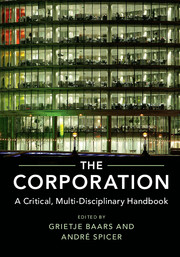Book contents
- Frontmatter
- Contents
- List of Contributors
- Acknowledgements
- Introduction: Why the Corporation?
- PART I DISCIPLINARY OVERVIEWS
- PART II INTERDISCIPLINARY THEMATIC CHAPTERS
- 1 The Evolution of the Corporate Form
- 2 The Multinational Corporate Group
- 3 The Financialization of the Corporation
- 4 Corporate Value Chains
- 5 Corporate Citizenship
- 6 The Corporation and Crime
- 7 The Corporation and Ideology
- 8 Corporation and Communities
- a Articulating and Disarticulating Corporation and Community
- b Communities Inside and Outside the Corporation: Control, Power and Interests
- c Coercion and Corporate Power: Notes on Class Struggle in an Indian City
- 9 Corporations and Resistance
- 10 Alternatives to the Corporation
- Index
- References
b - Communities Inside and Outside the Corporation: Control, Power and Interests
from 8 - Corporation and Communities
Published online by Cambridge University Press: 31 March 2017
- Frontmatter
- Contents
- List of Contributors
- Acknowledgements
- Introduction: Why the Corporation?
- PART I DISCIPLINARY OVERVIEWS
- PART II INTERDISCIPLINARY THEMATIC CHAPTERS
- 1 The Evolution of the Corporate Form
- 2 The Multinational Corporate Group
- 3 The Financialization of the Corporation
- 4 Corporate Value Chains
- 5 Corporate Citizenship
- 6 The Corporation and Crime
- 7 The Corporation and Ideology
- 8 Corporation and Communities
- a Articulating and Disarticulating Corporation and Community
- b Communities Inside and Outside the Corporation: Control, Power and Interests
- c Coercion and Corporate Power: Notes on Class Struggle in an Indian City
- 9 Corporations and Resistance
- 10 Alternatives to the Corporation
- Index
- References
Summary
Introduction
This chapter examines how critical analysis of communities inside and outside the corporation can provide valuable insights into the way communities emerge, are leveraged, are imbued with power and politics, and are used to serve the interests of different parties. The starting point for discussions is geographical and organization-studies literatures on corporate communities. In this work, one preoccupation is identifying how managers in corporations seek to construct communities (see, e.g., Amin and Cohendet, 2004; Faulconbridge, 2010). This work has been informed, in particular, by the communities-of-practice literature (Lave and Wenger, 1991; Wenger, 1998). A second preoccupation is analysing the various extra-firm communities that corporations participate in (see, e.g., Morgan, 2001; Bathelt et al., 2004; Maskell, 2014). The purpose here is to reveal the ways corporations define, exploit and contribute to communities outside of the organization's boundaries. The effects on institutions are afforded particular attention in this literature as part of efforts to understand how, through communities, corporations influence local and global governance regimes (see also Morgan, this volume; Sanchez, this volume).
In these literatures, the concept of the community is used in a variety of ways, from co-located workplace communities, to local host communities in a city or region, to transnational virtual communities. Whilst recognizing the limitations of such diverse conceptions, these literatures are useful because they reveal not only the centrality of, but also the sometimes insidious nature of, the communities created and leveraged by corporations. In particular, the chapter seeks to reveal the ways that communities are used by corporations as a means of control; power over communities without is used by corporations to allow goals to be achieved; and communities are used as means of protecting and promoting the interests of particular groups. The discussion thus reveals that critical analyses are crucial for bringing into view the multiple ways that communities can be used as a means of pursuing the interests of the capitalists driving corporations, this having potentially detrimental effects for workers and society. It is also noted, however, that communities might also be a means of resisting the control, power and interests of the corporation.
The rest of the chapter proceeds over four further sections. The next section considers how communities within the corporation have been studied, and the way these communities contribute to the innovative capacity and governance of corporations.
- Type
- Chapter
- Information
- The CorporationA Critical, Multi-Disciplinary Handbook, pp. 457 - 469Publisher: Cambridge University PressPrint publication year: 2017



